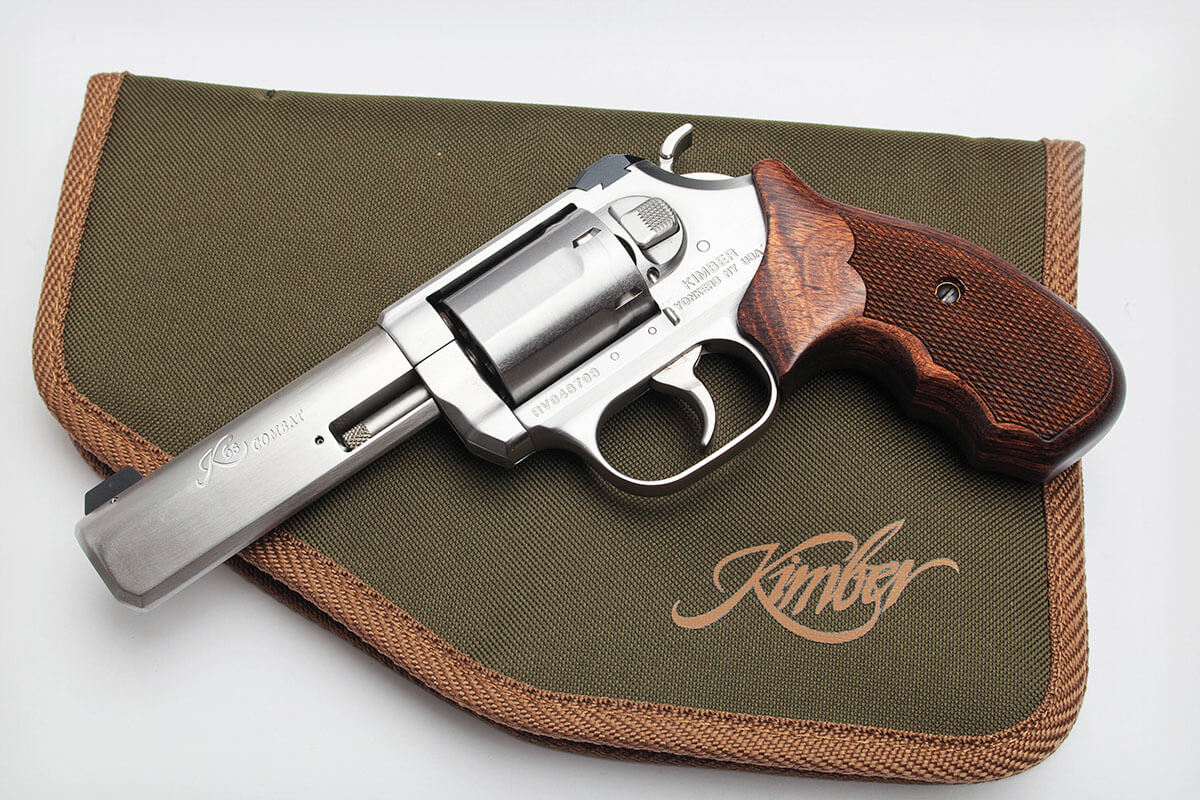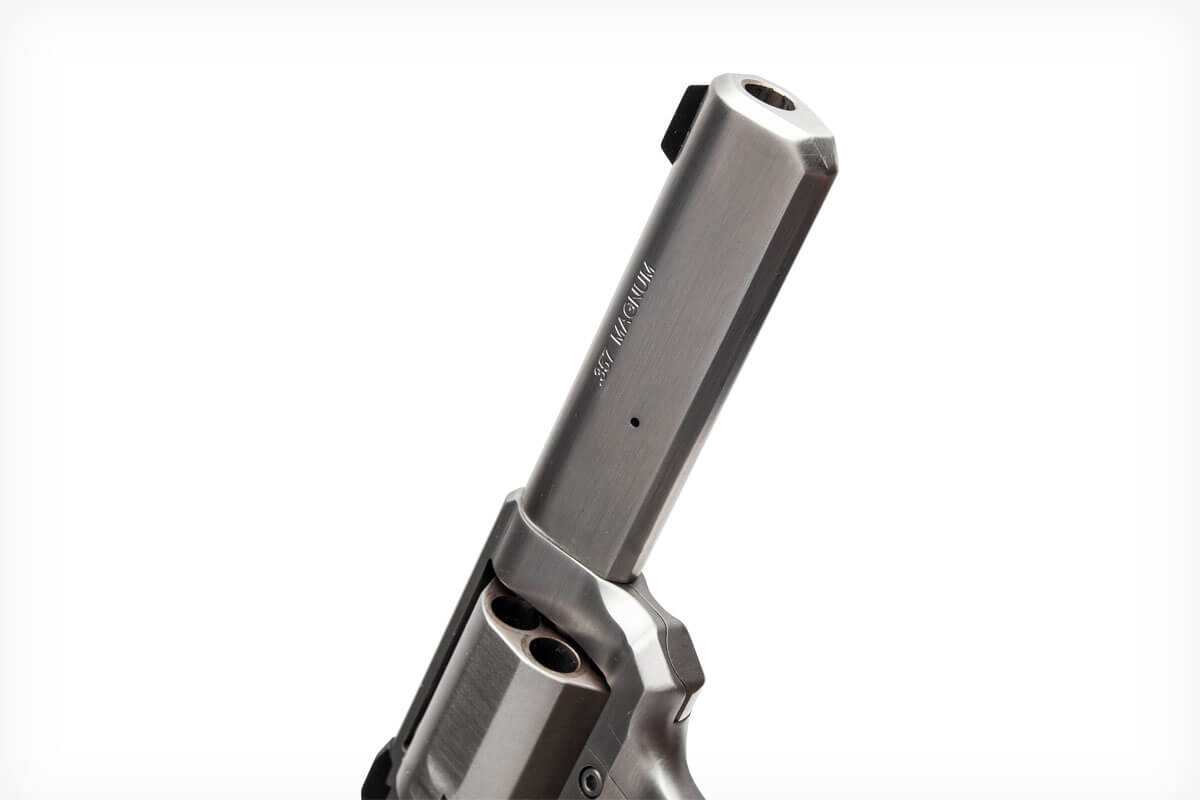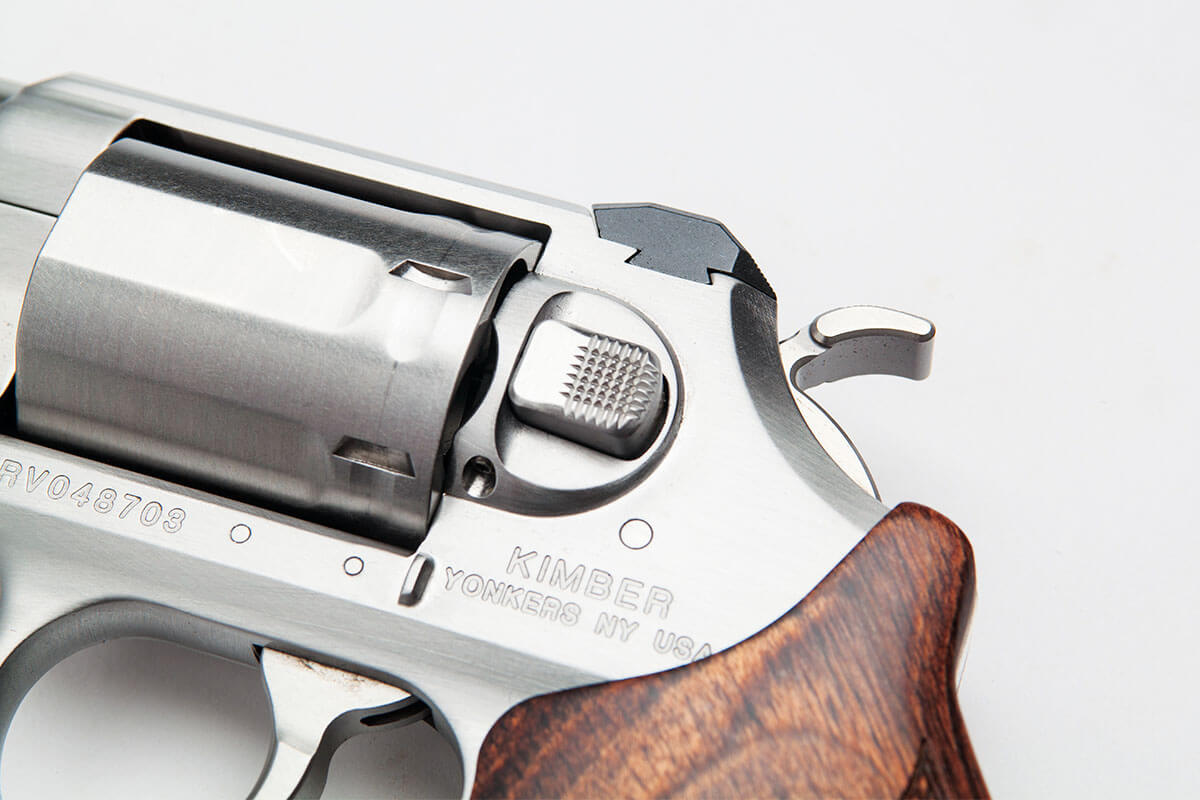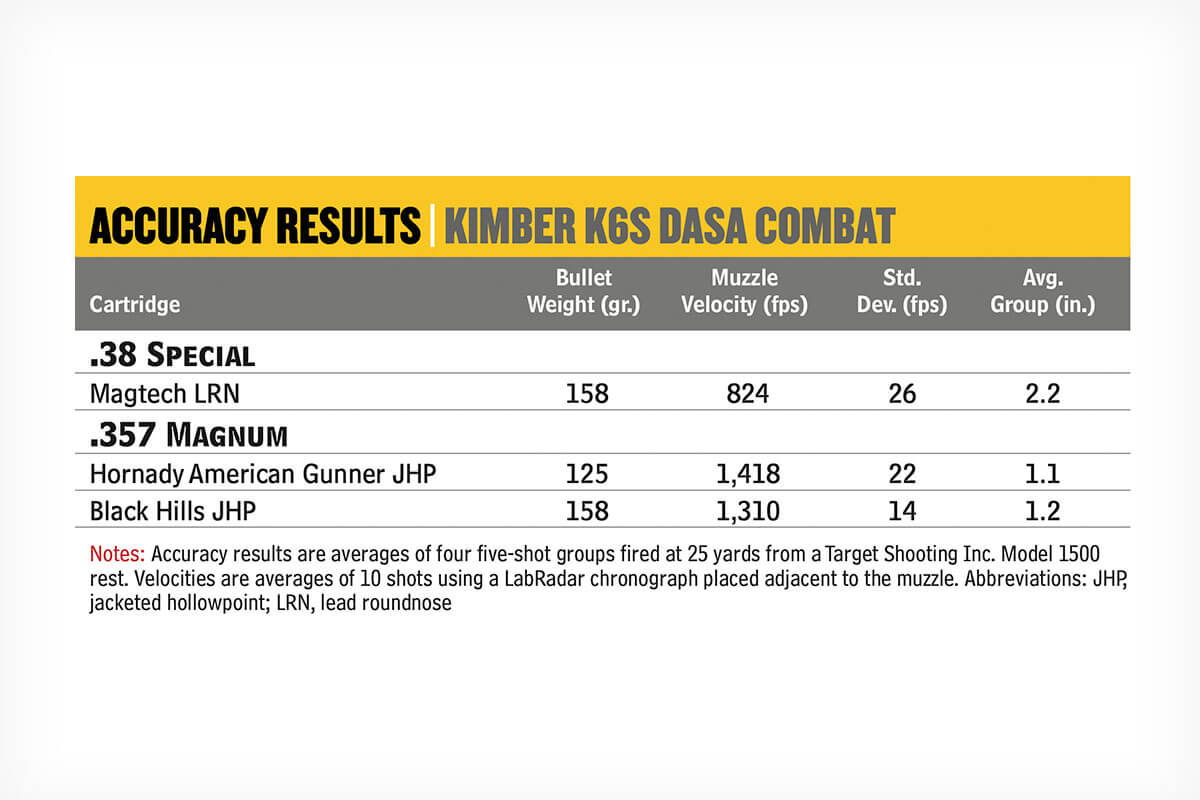
I’ve long been a revolver fan, so when I saw a major U.S. firearm manufacturer engineer a sixgun from the ground up, I was excited. Kimber’s K6s was introduced to consumers in 2016 with much fanfare. Revolvers, long considered dead, were making a comeback, and Kimber appeared to have timed the market perfectly.
The K6s was offered in different configurations, but all of them were snubnose, internal-hammer, double-action-only guns designed for concealed carry. That changed in 2019 when Kimber introduced the DASA, a traditional double-action/single-action revolver available with barrels up to four inches. Though less concealable, the K6s DASA family is far more capable.
The DASA is currently offered in four models. Two of them—the four-inch Target GFO and four-inch Target—have fully adjustable rear sights. The fixed-sight Combat models are available with three- and four-inch barrels, and I tested the latter.

I recently spent a day in Kimber’s Troy, Alabama, headquarters with a focus on the engineering work being done there. One of the products we focused on was the K6s series of revolvers, which gave me the opportunity for a deep dive into the guns’ construction and features with the team who designed them.
Metal injection molding (MIM) has become extremely popular in the firearm industry due to its ability to produce functional components at low cost. Though there is nothing inherently wrong with MIM parts, particularly if a firearm is engineered with those parts in mind, many purists lament their use. I am neither categorically pro nor anti MIM, but I don’t believe there is any question that fully machined parts, though more expensive to produce, are superior.
The K6s series of revolvers contains no MIM parts whatsoever, instead relying on components machined from bar stock in Kimber’s Yonkers, New York, facility. Manufacturing a revolver is an expensive proposition, made even more so by this type of construction. Everything but the grip panels and sights on the K6s are machined from stainless steel.
Like all K6s revolvers, the DASA Combat is chambered in .357 Magnum. With modern heat-treated steels, such a gun no longer needs to be bulky in order to handle the pressures generated by that cartridge. This model is surprisingly light and trim.
Frame-wise, the K6s is roughly the size of a Smith & Wesson K-frame revolver which makes for a very handy package. When compared to larger N-frame guns, the K6s looks downright tiny. The round-butt frame is just long enough to allow for a full-fingered grip on the gun, reducing another area that can ordinarily add bulk to a revolver.
Finally, the sides of the cylinder are milled flat between the chambers, which cuts down on width. Empty, the K6s weighs 29 ounces. If you were going to conceal a four-inch-barreled revolver, this would be a strong choice.

Let’s start with the barrel. Some revolver manufacturers have gone to a two-piece blank-and-sleeve arrangement to eliminate the necessity of timing the barrel to the frame. Kimber opted for a traditional one-piece barrel with a unique ovate profile, another sign that cost-cutting isn’t a priority for the company’s sixguns. A full-length underlug adds a bit of weight where it can be most effective in taming muzzle rise. The barrel-to-cylinder gap on the K6s measured 0.006 inch, which is on the tight side of average.
The six-shot cylinder on the K6s is counterbored, which means it is chambered so the rims of loaded cartridges are recessed within. This has become an unusual feature on double-action revolvers since the 1980s because it requires additional machining operations. Yet another shortcut averted. Cylinders can be charged individually or using machined aluminum speedloaders available from Kimber.
The Combat byname suggests a revolver that will most likely be fired double-action. Firing the K6s in this mode produces a trigger pull that measured 8.75 pounds on my test sample. This double-action pull was smooth. There was no “stacking” of the trigger, and the only indication that the shot is about to break is the bolt locking into the cylinder notch.
The K6s DASA uses two safeties. Kimber maintained the rebound safety found on the original K6s and added a transfer bar safety, which prevents the revolver from firing unless the trigger is pulled—a dual failsafe system.

With the sideplate off the K6s, Kimber engineers were able to show me firsthand how this system works. The transfer bar is the steel part that connects the falling hammer with the firing pin and only actuates with pressure on the trigger. If the transfer bar is not in its raised position, the gun cannot fire. So even if the K6s is dropped and the hammer falls, there is nothing to connect the hammer and firing pin. This is the case when the hammer is forward as well.
These safeties are completely passive; you won’t know they are there unless you look for them. In my opinion, anything that contributes to a safer gun and doesn’t have a negative effect on the trigger pull is a win.
While the K6s Target models come equipped with fully adjustable sights, the DASA Combat uses a more rigid arrangement. The steel front sight is pinned into the barrel and the rear rides in a dovetail. The rear sight is drift adjustable for windage once a vertical hex screw is loosened.
I found the white three-dot sight arrangement to be a good shooting aid, with just enough light visible on either side of the front blade to balance precision and speed. The test sample shot to point of aim with all of the loads tested, which ranged from light .38 Special loads to powerful defensive .357 Magnum ammunition. The lack of adjustability was not an issue.
The trigger on the K6s DASA Combat is smooth, and the hammer is checkered for a positive grip. The port-side cylinder release is checkered as well and is accessible without having to shift one’s grip on the gun.
With the cylinder unlocked, a standard-type ejector rod is used to unload the K6s. The cylinder locks both at the rear and at the front of the ejector rod where it interfaces with a spring-loaded detent in the barrel.
The only non-steel parts on the K6s are the grips. Made from two panels of laminated wood, the stocks on the K6s DASA Combat are functional and attractive. Two finger grooves are located on the frontstrap that, combined with the diamond pattern checkering, help the shooter control the gun in recoil.
My hands are about average in size, and I found the factory grips to be comfortable and functional. At this time, other options are limited because factory grips designed for the double-action-only K6s are not compatible with the DASA. However, aftermarket grips such as those from Hogue are compatible.
Overall, the fit and finish on our sample gun was excellent. The entire K6s DASA Combat is completely de-horned for carry, meaning there are no sharp edges that will cut into skin or clothing. The brushed satin stainless steel finish is even and attractive.

On the day I took the K6s to the range for our formal accuracy testing, it took its place in line behind a handgun that retailed for about five times the Kimber’s suggested retail price. I guess I wasn’t expecting much after shooting the heirloom-priced handgun, which was one of the most accurate guns I’ve ever tested. Imagine my surprise when the first five-shot group out of this Kimber landed in a single ragged hole at 25 yards, nearly besting the high-dollar model. Repeated groups achieved the same result. In terms of its accuracy potential, this K6s takes a backseat to no gun.
Due to the ammo shortage situation when I was testing this gun, I was able to shoot only three loads, but nevertheless, I got a good view of what this gun is capable of. Despite being a relatively light and compact revolver, recoil was not oppressive even with full-power .357 Magnum loads.
Accuracy was great, but that’s not the final answer when it comes to how useful a handgun can be in the practical sense. After the bench testing was finished, I transitioned to steel targets at various ranges. Firing the K6s double-action, I quickly came to appreciate how shootable the gun is. Good sights, a great trigger and controllable recoil were all part of the experience and took me back to my earliest days on the range when my .357 Magnum revolver was my only centerfire handgun.
Revolvers are complicated firearms and therefore not at all inexpensive to manufacture. The suggested retail price on the DASA Combat is $1,046, and street prices appear to hover roughly $100 below that number, even in this market. Put in context, the Kimber splits the price difference between comparable revolvers made by Smith & Wesson and Ruger. Neither of those companies can boast the use of fully machined parts in their models, further demonstrating the value of the K6s series. Once you shoot the K6s, the price begins to look very reasonable.

Further, not every shooter is comfortable with keeping a loaded semiauto in their home or on their person. Given the millions of new, inexperienced individuals who have become gun owners since the spring of 2020, we may see an entire new demand for the simplicity and reliability of a defense-oriented revolver. The K6s DASA Combat fits comfortably in that role.
As I learned during my visit to Kimber’s Alabama facility, this is not a product that was rushed to the market to meet the latest trend. The K6s series of revolvers is carefully engineered and refined, and the DASA is the latest evolution of that design and innovation effort. Given the K6s DASA Combat’s range performance, it’s clear that Kimber’s engineers did their job well. I can’t wait to see what the company comes up with next. If a simple, reliable, powerful and well-built handgun piques your interest, this one is worth a long look.
Kimber K6s DASA Combat Specification
- Type: double-action/single-action revolver
- Caliber: .357 Magnum/.38 Special
- Capacity: 6
- Barrel: 4 in.
- Weight: 29 oz.
- Construction: machined stainless steel
- Grips: laminated hardwood
- Sights: three-dot steel front and rear, drift adjustable for windage
- Trigger: 3.3 lb. single-action pull, 8.75 lb. double-action pull
- Price: $1,046
- Manufacturer: Kimber Manufacturing, kimberamerica.com

